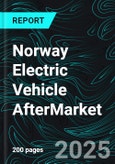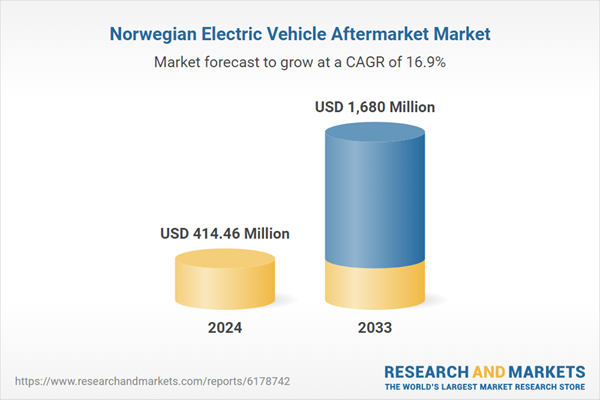Norway Electric Vehicle Aftermarket Industry Overview
The variety of goods, services, and solutions that are offered following the initial sale of an electric vehicle (EV) is referred to as the EV aftermarket. It covers upkeep, repairs, software updates, battery refurbishing, replacement parts, charging options, and performance improvements. Although EVs have fewer mechanical parts than conventional cars, their batteries, electronics, and software systems still need particular care. Second-life battery apps, energy management tools, and accessories are also included in the aftermarket. This market is expanding because to factors like aging fleets, growing EV usage, and customer desire for affordable solutions, making it an essential component of the changing sustainable mobility ecosystem.A number of important factors are driving the expansion of Norway's EV aftermarket. Norway has a sizable and aged fleet of EVs that need maintenance, battery replacements, and upgrades as a result of its leading EV adoption, which is aided by government subsidies and tax breaks. Increasing the infrastructure for charging EVs promotes increased use of EVs, which enhances aftermarket services. Demand for environmentally friendly products and services is driven by consumers' growing preference for sustainable modes of transportation. Cost-effective repair and maintenance are also becoming more and more necessary as used EV sales rise. Norway is now a center for cutting-edge EV aftermarket solutions thanks to technological developments in diagnostics, software upgrades, and battery management that enhance aftermarket prospects.
Growth Drivers for the Norway Electric Vehicle Aftermarket Market
High EV Adoption Rate
With EVs accounting for the majority of new car sales, Norway is the world leader in the adoption of EVs. A sizable installed base of EVs has been produced by this quick penetration, which has positively impacted the aftermarket industry. The demand for software upgrades, spare parts, diagnostic services, and battery replacements rises with the size of the EV fleet. Unlike conventional cars, EVs need specific aftermarket solutions, especially for electronic parts and battery management. The need for reasonably priced maintenance and repairs is further bolstered by the growing number of used EVs. The EV aftermarket will grow gradually because to Norway's aggressive policies and consumers' passion for environmentally friendly transportation, which is supported by the country's unparalleled adoption rate.Expanding Charging Infrastructure
An important factor propelling the EV aftermarket in Norway is the country's strong and quickly expanding charging infrastructure. Customers are more comfortable embracing and utilizing EVs for both short-distance and long-distance travel thanks to vast networks of fast and home chargers. As EV usage rises, batteries, tires, and other parts experience increased wear and tear, which increases the need for aftermarket goods and services. Furthermore, new prospects for aftermarket upgrades and maintenance services are created by modern charging solutions like smart chargers and vehicle-to-grid (V2G) systems. The nation's dedication to providing statewide coverage guarantees that EVs are still useful throughout the year, and the expansion of this infrastructure immediately raises the aftermarket's profile and potential for profit.Sustainability Goals
Norway's lofty climate goals and strong sustainability pledges are key factors driving the aftermarket for electric vehicles. As a result of the government's goal to phase out internal combustion engine (ICE) cars, EV adoption has increased and the aftermarket base has grown. Eco-friendly mobility is becoming more and more important to consumers, who are looking for sustainable alternatives including recycled parts, reconditioned batteries, and green maintenance techniques. This opens doors for businesses that provide circular economy models, second-life battery uses, and energy-efficient services. Furthermore, companies are under pressure to comply with national decarbonization regulations, which encourages aftermarket service innovation. Sustainability objectives not only hasten the adoption of EVs but also guarantee that the aftermarket develops as a pillar of Norway's green transition by fusing consumer demand with regulatory pressure.Challenges in the Norway Electric Vehicle Aftermarket Market
High Dependence on Imports
The issue facing Norway's electric vehicle (EV) aftermarket is its significant reliance on imported components, especially electronic, semiconductor, and battery parts. Due to the absence of extensive EV manufacturing facilities in the nation, the majority of essential parts must be imported. Due to this dependence, the aftermarket is more vulnerable to global supply chain disruptions like material shortages or geopolitical conflicts, which raises costs and lengthens lead times. Pricing for imported parts is further impacted by fluctuating currency exchange rates. The need for reasonably priced replacement batteries and spare parts will increase as EV adoption picks up speed. Without more robust local supply chains, Norway's aftermarket may face constraints on availability and cost.High Initial Outlay of Funds
For Norway's EV aftermarket, battery recycling and disposal present a significant obstacle. Because lithium-ion batteries have a short lifespan, the quantity of end-of-life batteries is increasing as the nation's EV fleet ages. Advanced technology and specialized facilities are necessary for proper recycling, yet both are still scarce in the country. Complexity is increased by exorbitant expenses, environmental issues, and safety dangers like fire hazards. Furthermore, aftermarket participants face greater compliance obligations due to stringent EU and Norwegian rules that require sustainable handling. The aftermarket runs the potential of causing battery shortages, increased replacement costs, and environmental problems in the absence of effective recycling facilities, which would jeopardize Norway's larger sustainability and green mobility objectives.Oslo Electric Vehicle Aftermarket Market
As Norway’s capital and most urbanized region, Oslo plays a central role in the country’s electric vehicle (EV) aftermarket. With one of the highest EV adoption rates, the city generates significant demand for maintenance, battery replacement, charging infrastructure services, and software upgrades. Oslo’s dense charging network and strong sustainability initiatives encourage widespread EV usage, creating continuous aftermarket opportunities. The concentration of service providers, dealerships, and technology firms also fosters innovation in EV diagnostics and energy management. However, challenges such as high service costs, limited workshop capacity, and dependence on imported parts highlight the need for efficient, scalable aftermarket solutions.Viken Electric Vehicle Aftermarket Market
Viken, Norway’s most populous county, represents a vital market for the EV aftermarket due to its large commuter population and growing electric vehicle ownership. Its extensive road networks and reliance on daily commuting increase wear and tear on EVs, driving demand for replacement parts, battery maintenance, and charging-related services. Viken benefits from its proximity to Oslo, giving it access to advanced aftermarket providers and suppliers. The region also has a growing number of used EVs, fueling demand for cost-efficient repairs and refurbished components. Still, challenges such as service accessibility in rural areas and skilled labor shortages shape the aftermarket landscape.Vestland Electric Vehicle Aftermarket Market
Vestland, with its mix of urban centers like Bergen and challenging geographical terrain, presents unique dynamics for the EV aftermarket. The region’s strong EV adoption, supported by government incentives and expanding charging infrastructure, creates growing demand for specialized services such as battery maintenance and software diagnostics. Harsh weather conditions and long travel distances increase pressure on EV performance, further driving aftermarket needs. Additionally, Vestland’s focus on sustainability supports growth in recycling and second-life battery solutions. However, the region faces challenges such as limited workshop networks in remote areas and higher logistics costs, which can affect affordability and service efficiency.Rogaland Electric Vehicle Aftermarket Market
Rogaland, home to Stavanger and Norway’s energy hub, is an emerging growth area for the electric vehicle (EV) aftermarket. With strong EV adoption supported by government incentives and a well-developed charging infrastructure, demand for maintenance, battery servicing, and diagnostic solutions is rising. The region’s economic focus on energy and technology fosters innovation in EV-related services, including smart charging and energy storage integration. Frequent commuting and coastal weather conditions increase wear on EV components, boosting aftermarket needs. However, Rogaland faces challenges such as dependence on imported spare parts and a shortage of specialized EV technicians, impacting service efficiency and affordability.Norway Electric Vehicle Aftermarket Market Segments:
Type
- Tire
- Market Analysis
- Battery
- Brake Parts
- Filters
- Body Parts
- Lighting & Electronic Components
- Wheels
- Others
Form
- Passenger Car
- Commercial Vehicle
Distribution Channel
- Authorized Service Centers (OEMs)
- Premium multi-brand service center
- Digital Aggregators
- Others
States
- Oslo
- Viken
- Vestland
- Rogaland
- Trøndelag
- Vestfold og Telemark
- Innlandet
- Agder
- Møre og Romsdal
- Troms og Finnmark
All companies have been covered from 5 viewpoints:
- Company Overview
- Key Persons
- Recent Development & Strategies
- SWOT Analysis
- Sales Analysis
Key Players Analysis
- 3M
- ABB Ltd.
- EVBox Group
- ChargePoint Inc.
- Webasto SE
- Siemens AG
- Bosch Automotive Sevrice Solution Inc.
- Schneider Electric SE
Table of Contents
Companies Mentioned
- 3M
- ABB Ltd.
- EVBox Group
- ChargePoint Inc.
- Webasto SE
- Siemens AG
- Bosch Automotive Sevrice Solution Inc.
- Schneider Electric SE
Methodology
In this report, for analyzing the future trends for the studied market during the forecast period, the publisher has incorporated rigorous statistical and econometric methods, further scrutinized by secondary, primary sources and by in-house experts, supported through their extensive data intelligence repository. The market is studied holistically from both demand and supply-side perspectives. This is carried out to analyze both end-user and producer behavior patterns, in the review period, which affects price, demand and consumption trends. As the study demands to analyze the long-term nature of the market, the identification of factors influencing the market is based on the fundamentality of the study market.
Through secondary and primary researches, which largely include interviews with industry participants, reliable statistics, and regional intelligence, are identified and are transformed to quantitative data through data extraction, and further applied for inferential purposes. The publisher's in-house industry experts play an instrumental role in designing analytic tools and models, tailored to the requirements of a particular industry segment. These analytical tools and models sanitize the data & statistics and enhance the accuracy of their recommendations and advice.
Primary Research
The primary purpose of this phase is to extract qualitative information regarding the market from the key industry leaders. The primary research efforts include reaching out to participants through mail, tele-conversations, referrals, professional networks, and face-to-face interactions. The publisher also established professional corporate relations with various companies that allow us greater flexibility for reaching out to industry participants and commentators for interviews and discussions, fulfilling the following functions:
- Validates and improves the data quality and strengthens research proceeds
- Further develop the analyst team’s market understanding and expertise
- Supplies authentic information about market size, share, growth, and forecast
The researcher's primary research interview and discussion panels are typically composed of the most experienced industry members. These participants include, however, are not limited to:
- Chief executives and VPs of leading corporations specific to the industry
- Product and sales managers or country heads; channel partners and top level distributors; banking, investment, and valuation experts
- Key opinion leaders (KOLs)
Secondary Research
The publisher refers to a broad array of industry sources for their secondary research, which typically includes, however, is not limited to:
- Company SEC filings, annual reports, company websites, broker & financial reports, and investor presentations for competitive scenario and shape of the industry
- Patent and regulatory databases for understanding of technical & legal developments
- Scientific and technical writings for product information and related preemptions
- Regional government and statistical databases for macro analysis
- Authentic new articles, webcasts, and other related releases for market evaluation
- Internal and external proprietary databases, key market indicators, and relevant press releases for market estimates and forecasts

LOADING...
Table Information
| Report Attribute | Details |
|---|---|
| No. of Pages | 200 |
| Published | September 2025 |
| Forecast Period | 2024 - 2033 |
| Estimated Market Value ( USD | $ 414.46 Million |
| Forecasted Market Value ( USD | $ 1680 Million |
| Compound Annual Growth Rate | 16.8% |
| Regions Covered | Norway |
| No. of Companies Mentioned | 8 |









